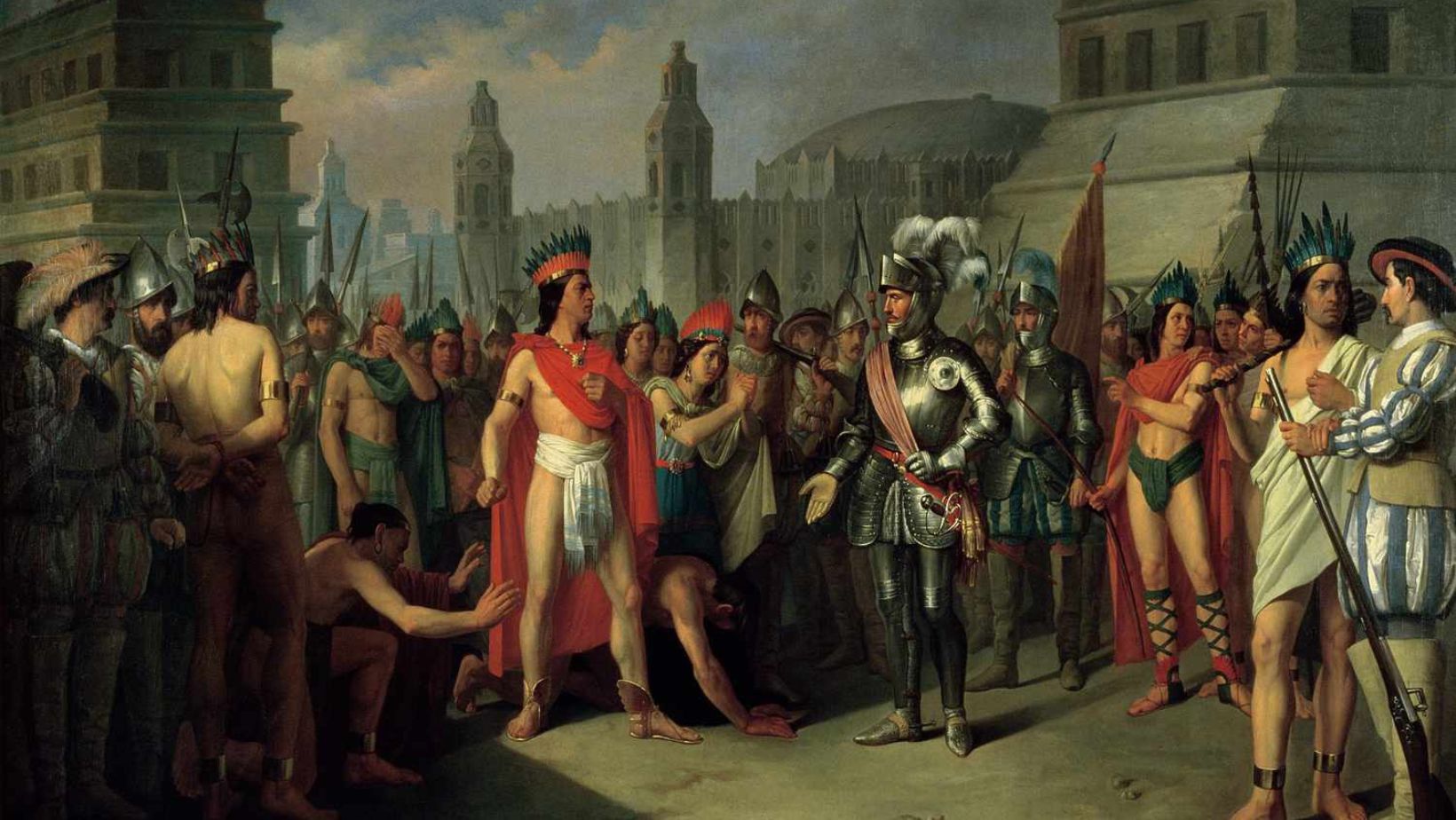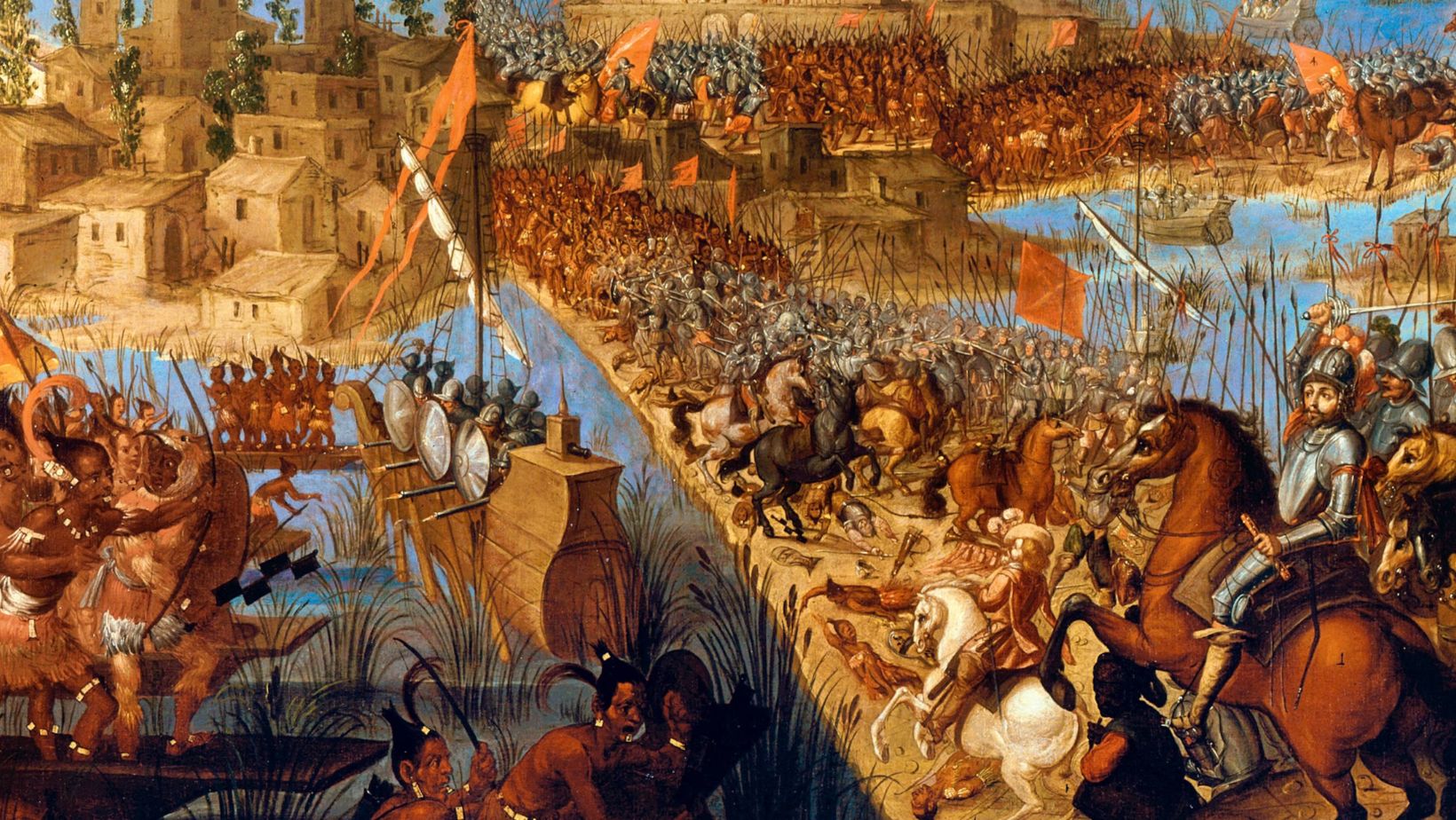Cuauhtémoc, the last emperor of the Aztecs, is a powerful symbol of resistance and resilience. His leadership during one of the most tumultuous periods in Mesoamerican history defines his legacy. When the Spanish conquistadors, led by Hernán Cortés, invaded in the early 16th century, Cuauhtémoc rose to the challenge, fighting fiercely to protect his people and their way of life. His determination and bravery during the Spanish conquest left an indelible mark on Mexican history. In this blog, we will explore Cuauhtémoc’s life, his valiant stand against Spanish forces, and the lasting impact of his legacy today.
The Aztec Empire Before the Conquest

Before the Spanish conquest, the Aztec Empire was a powerful and complex civilization that flourished in Mesoamerica. At its height, the empire encompassed much of present-day Mexico, with Tenochtitlán as its capital. The society was structured hierarchically, with an emperor at the top, followed by nobles, priests, and commoners. This system facilitated efficient governance and allowed for impressive achievements in architecture, agriculture, and art.
The Aztecs were known for their advanced agricultural techniques, including chinampas, or floating gardens, which maximized crop yields. They also excelled in trade, connecting various regions through a vast network. Culturally, the Aztecs practiced rich traditions, including elaborate rituals and a pantheon of gods that influenced daily life.
Leading up to the Spanish arrival, the empire was marked by both prosperity and tension. While Cuauhtémoc’s predecessors expanded their territory through conquest, they also faced growing unrest among subjugated peoples. This socio-political landscape created a sense of vulnerability, making the empire ripe for external threats, particularly from Hernán Cortés and his forces. The Aztec Empire was a remarkable civilization on the brink of profound change.
The Arrival of Hernán Cortés
Hernán Cortés arrived in the Aztec Empire in 1519, driven by ambitions of conquest and wealth. His expedition began in Cuba, where he gathered a small force of soldiers, horses, and ships. Cortés set sail for the mainland, landing on the coast of Mexico. His goal was to explore and ultimately seize the riches rumored to be within the Aztec territory.
Upon reaching the Aztec Empire, Cortés made contact with local tribes, seeking alliances against the Aztecs. He quickly learned of the wealth in Tenochtitlán, the empire’s capital, which fueled his desire to conquer it. The initial encounters between the Spaniards and Aztecs were marked by curiosity and caution.
Cortés’s men were initially received as guests, and he was greeted by emissaries from the Aztec emperor, Moctezuma II. However, tensions soon escalated as Cortés began to assert dominance. His arrival set off a chain of events that would lead to a brutal confrontation, forever changing the course of history for the Aztec Empire. The meeting of these two worlds marked the beginning of a dramatic conflict.
Cuauhtémoc Rise to Power
Cuauhtémoc’s rise to power as the last Aztec emperor was shaped by a series of pivotal events. Following the death of Emperor Moctezuma II, the empire faced a leadership crisis amid increasing Spanish aggression. Cuauhtémoc was appointed as emperor in 1520, during a time of turmoil and uncertainty. His selection was partly due to his noble lineage and reputation as a fierce warrior.
As emperor, Cuauhtémoc demonstrated a strong leadership style focused on unity and resilience. He recognized the need for a consolidated front against the Spanish invaders. Cuauhtémoc implemented strategies to bolster the morale of his people and reinforce their defenses. He rallied the Aztec warriors and sought alliances with other tribes, aiming to strengthen the empire’s position.
His policies emphasized a return to traditional Aztec values, fostering pride in their cultural heritage. Cuauhtémoc also prioritized military preparedness, ensuring that his forces were ready to confront the formidable Spanish army. Under his leadership, the Aztec Empire prepared for an epic struggle for survival against foreign domination, marking a critical chapter in its history.
The Siege of Tenochtitlán

The Siege of Tenochtitlán began in May 1521 and marked a crucial turning point in the Spanish conquest of the Aztec Empire. Hernán Cortés, along with his allies, launched a full-scale assault on the capital, which was a marvel of engineering and culture. The siege was significant as it demonstrated the strategic importance of Tenochtitlán, both as the heart of the Aztec Empire and a symbol of indigenous resistance.
Cuauhtémoc played a vital role during the siege, leading his people with courage and tenacity. He organized the defense of the city, rallying warriors and coordinating counterattacks against the Spanish forces. Cuauhtémoc utilized the city’s canals and waterways to hinder the enemy’s movements, showcasing his tactical acumen. Despite being outnumbered and facing dwindling resources, he remained determined to defend Tenochtitlán against the relentless assault.
The siege lasted for months, with fierce battles taking place both in the city and around its outskirts. Cuauhtémoc’s leadership inspired fierce loyalty among the defenders, and he became a symbol of resistance. However, as the siege intensified, food shortages and disease weakened the Aztec defenses. Ultimately, Tenochtitlán fell to the Spanish in August 1521, marking a tragic end to the Aztec Empire.
Tactics of Resistance: Cuauhtémoc
Cuauhtémoc employed various military strategies to resist the Spanish invasion during the conquest of Tenochtitlán. His tactics included guerrilla warfare, which involved surprise attacks on Spanish forces and quick retreats into the city’s labyrinth of canals. This approach allowed the Aztecs to leverage their knowledge of the terrain and maintain an element of surprise against their more heavily armed adversaries. Cuauhtémoc also used the city’s waterways to disrupt enemy supply lines and transport.
Alliances with other indigenous groups were crucial to Cuauhtémoc’s strategy. Recognizing the need for unity against the common enemy, he sought to form coalitions with tribes disillusioned by Spanish brutality. By rallying support from groups like the Tlaxcalans and others, Cuauhtémoc aimed to create a formidable force against the Spanish. These alliances were significant not only for bolstering numbers but also for sharing intelligence and resources.
Despite his strategic efforts, Cuauhtémoc faced numerous challenges, including internal dissent and a lack of supplies. The Spanish, with their advanced weaponry and relentless pursuit, ultimately overwhelmed these resistance tactics. Nevertheless, Cuauhtémoc’s military strategies and efforts to unite various tribes showcased his determination to protect his people and heritage against foreign domination.
The Fall of Tenochtitlán: Cuauhtémoc
The Fall of Tenochtitlán was a culmination of key events that unfolded during the siege led by Hernán Cortés. After months of intense fighting, the Spanish forces intensified their assaults in July 1521. They employed heavy artillery and brought reinforcements, effectively surrounding the city and cutting off essential supplies. As food and water became scarce, the once-thriving metropolis began to weaken.
Cuauhtémoc continued to lead his people with determination, but the relentless pressure from the Spanish forces took its toll. In a desperate bid to defend the city, he organized a final stand, rallying the remaining warriors. The fighting became increasingly brutal as the Spanish troops breached the city’s defenses. Cuauhtémoc’s forces fought valiantly, but the overwhelming numbers and resources of the Spanish proved insurmountable.
On August 13, 1521, Cuauhtémoc was captured as he attempted to flee the burning city. His bravery and leadership had earned him deep respect among his people, but the fall of Tenochtitlán marked the end of the Aztec Empire. This pivotal moment reshaped the history of Mexico and left a lasting impact on indigenous culture and identity. Cuauhtémoc’s capture symbolized the tragic loss of an entire civilization.
The Aftermath of Conquest: Cuauhtémoc
The aftermath of the conquest had devastating effects on the Aztec civilization. Cuauhtémoc’s defeat marked the end of a sophisticated empire that had thrived for centuries. The Spanish forces began to dismantle the existing social, political, and economic structures, leading to widespread chaos and dislocation among the indigenous population. Many Aztec traditions, religious practices, and languages faced erosion as Spanish colonial influence took hold.
Following the conquest, the Spanish established colonial rule over the region, asserting their dominance through force and intimidation. They imposed a new governance system, with Spanish officials controlling resources and land. This shift also included the introduction of the encomienda system, where Spanish settlers were granted rights to labor from indigenous people. This system led to severe exploitation and harsh treatment of the native population.
Additionally, the Spanish imposed Christianity on the Aztecs, often through violent means. Temples and sacred sites were destroyed, and churches were built in their place. The cultural identity of the Aztecs faced significant threats, with many practices being outlawed or forcibly suppressed. The legacy of Cuauhtémoc’s resistance ultimately symbolizes the struggle for indigenous identity amid colonial oppression.
Cuauhtémoc Legacy

Cuauhtémoc is remembered as a symbol of resistance and resilience in Mexican culture and history. His bravery during the Spanish conquest has made him a national hero. Statues and monuments honoring him can be found throughout Mexico, serving as a reminder of his fight against colonization. Cuauhtémoc’s legacy inspires pride in indigenous heritage and cultural identity.
In contemporary discussions, Cuauhtémoc represents the struggle against oppression and injustice. Activists often invoke his name to symbolize the fight for indigenous rights and sovereignty. His story resonates with marginalized communities seeking to reclaim their heritage and advocate for social justice. Cuauhtémoc’s legacy is also evident in literature, art, and education, where he is portrayed as a warrior who defended his people and culture.
His figure serves as a powerful reminder of the impact of colonialism on indigenous civilizations. Cuauhtémoc embodies the spirit of resistance that continues to inspire movements for equality and recognition. In this way, his legacy transcends history, becoming a vital part of Mexico’s national identity and ongoing quest for social justice.
Conclusion: Cuauhtémoc
Cuauhtémoc’s fight against the Spanish conquest remains a powerful symbol of resistance for many. His leadership during the siege of Tenochtitlán showcased not only bravery but also the determination to protect Aztec culture and sovereignty. Although he ultimately faced defeat, Cuauhtémoc’s legacy endures in contemporary discussions about indigenous rights and social justice. He is celebrated as a figure of strength and resilience, inspiring movements that advocate for the recognition and respect of indigenous cultures. Cuauhtémoc’s story reminds us of the importance of standing firm against oppression, making him a lasting icon in the struggle for justice.
FAQs
Who was Cuauhtémoc before he became Emperor?
Cuauhtémoc was a military leader and a member of the Aztec nobility. Before his ascension as emperor, he was known for his strategic skills and bravery in battle. He was also a close relative of the previous emperor, Moctezuma II, and gained recognition for his leadership during conflicts with neighboring tribes.
What were the primary challenges Cuauhtémoc faced during the Spanish conquest?
Cuauhtémoc faced numerous challenges, including limited resources, the spread of disease, and the superior weaponry of the Spanish forces. He also dealt with internal dissent and the need to unite various indigenous groups against a common enemy. The siege’s relentless pressure further strained his leadership and the morale of his people.
How did Cuauhtémoc’s leadership differ from that of Moctezuma II?
Cuauhtémoc’s leadership was marked by a more aggressive and unyielding stance against the Spanish compared to Moctezuma II, who initially sought diplomacy. Cuauhtémoc focused on rallying his people for resistance, while Moctezuma was often criticized for his cautious approach, which some believe contributed to the fall of Tenochtitlán.
What role did alliances play in Cuauhtémoc’s resistance efforts?
Alliances with other indigenous groups were crucial for Cuauhtémoc’s resistance. He sought to unite various tribes against the Spanish threat, recognizing that a collective effort was essential for survival. These alliances aimed to strengthen military capacity and bolster resources, although some alliances were fraught with mistrust and differing agendas.
How is Cuauhtémoc celebrated today in Mexico?
Today, Cuauhtémoc is celebrated as a national hero in Mexico. His legacy is honored through monuments, museums, and cultural festivals. Additionally, his story is integrated into educational curricula and serves as a symbol of indigenous pride and resistance against colonial oppression, inspiring movements advocating for indigenous rights and social justice.

